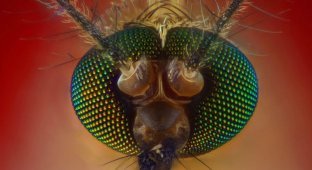These butterflies use their proboscis, like a mosquito's, to drink the blood of warm-blooded animals. At the same time, human blood is the most pleasant delicacy for them. And now the not-so-good news: the habitat of these insects is expanding more and more. They used to live only in Malaysia and Southern Europe, but chances are they will soon be near you.

So let's find out more about them...

Some tropical butterflies are bloodsuckers. Their rough proboscis is capable of piercing the skin of mammals. It is believed that at first the butterflies pierced the skin of the fruit to drink the juice, and then they became accustomed to drinking blood. In the tropics there are butterflies that feed on the tear secretions of animals, mainly ungulates, such as buffalos. These butterflies launch their long proboscis into the tear ducts and suck out the tear secretions. This is perhaps the only case when butterflies are carriers of diseases, in this case eye diseases.
Cutworms (“little owls”) belong to the Noctuidae family, the largest among butterflies: more than 30,000 species. Some cutworms also suck up droplets of blood from wounds (Lobocraspis griseifusca), but are not capable of piercing intact skin.

In 2006, Jennifer Zaspel was bitten by a vampire. The vampire was not in a black cloak, with a pale face and long teeth. It was a moth, and it was a real vampire.
Dr. Zaspel is a biologist who studies insects at Indiana University. On one of her trips, she went to Russia to study the moth "Calyptra thalictri". These insects feed on the juice of certain fruits such as grapes, raspberries and peaches. The moth pierces the skin of the berry and sucks out the sweet juice with its long proboscis. But this moth does not only feed on juice.
Zaspel caught one specimen of the moth and kept it in a plastic bottle from hand to mouth for several hours. Then she stuck her thumb into the neck. A few minutes later, the moth settled on the biologist’s thumb and, having pierced the skin at the base of the nail, began to drink human blood.
The moth Calyptra thalictri is just one of many vampire animals. The most famous vampires are ticks, mosquitoes, bedbugs and, of course, bats. Being a bloodsucker is not easy, and the animals have to find different ways to select and attack their victims.
The moth that Zaspel studied is only one representative of vampire insects. Some species of the genus Calyptra butterflies feed on the blood of large mammals - rhinoceroses and elephants, and some prefer the tear fluid of these animals. But not all butterflies, even within the same species, feed on fresh blood.
Scientists who studied these insects caught 16 Calyptra individuals. All 16 butterflies were given the chance to suck blood, but only three pierced the skin with their proboscis and began to feed on the scientists’ blood. Others didn't even try.

True blood feeding has been recorded in noctuid moths of the genus Calyptra, which live in Southeast Asia. Calyptra eustrigata is a medium-sized butterfly in which the females pierce various fruits and suck out their contents.
Males have the same rigid proboscis as females, but do not feed on fruits. At night, they attack elephants, tapirs, rhinoceroses, buffaloes and pierce the skin, rapidly vibrating with their hard, sharp proboscis with teeth at the end - like a jackhammer. This butterfly bites very painfully, and drinks blood at a time from five to thirty minutes. An experiment was carried out, and it turned out that males can drink human blood - they pierced the experimenter’s finger, the sensation was like being pricked by a hot needle. Blood drinking for these butterflies became possible due to the fact that their ancestors switched to feeding on dense fruits and developed a hard proboscis.

As terrible as it may sound, bloodsucking butterflies were discovered in our Siberia. They turned out to be cutworms or night moths. Yes, yes, those same big night moths that flock to the light in the evenings and at night are not averse to tasting human blood.
How the calyptra thalictri (lat. Calyptra thalictri) drinks human blood was first discovered in Russia, in the Far East. Lepidopterologist (butterfly specialist) Vladimir Kononenko, observing the behavior of the butterfly, noticed that the calyptra, if no one bothers it, can suck blood for several minutes.
These butterflies usually drink liquid from the eyes of animals, but it is possible that they can also fly to the smell of blood if, for example, a person is injured. Like most butterflies, the bloodthirsty moth flies to the light and the smell of red wine, to which sugar has been added. Calyptra can be a carrier of diseases. The proboscis of the calyptra has suction cups to attach to the skin. As a rule, the proboscis of butterflies is intended for drinking water and plant juice.
The length of the butterfly, with a wingspan, is 35-72 millimeters. Their long, hard proboscis is equipped with tiny suckers to attach to the skin. It was originally intended for drinking plant sap and water. Butterflies have adapted to pierce the hard skin of fruits. Some tropical species drink the tear secretions of large animals instead of blood.
The proboscis prick is quite painful. The bite site does not itch, but a small wound may bleed for a long time. If the butterflies are not driven away from the bite site, they can suck blood for 5 to 20 minutes.

The question arises: why do they still need blood? It’s not just that they switched to such an exotic cuisine. There is the following assumption, which, however, has not yet been precisely established. The blood of animals contains salt, which the males transfer to the female during mating. This “unusual sexual gift” provides salt to the butterfly larvae. Salt, or rather sodium, is necessary for their normal development.

A previously unknown population of vampire butterflies has been found and described by scientists in Siberia. Entomologists from the University of Florida (UF) believe that bloodthirsty insects have evolved from ordinary “fruit-eating” relatives.
Judging by the slight differences in the wing patterns, the little blood lovers are closely related to the cornflower cutworm (Calyptra thalictri), a butterfly common in central and southern Europe and some other parts of the world.
During the experiment, scientists donated their hands to butterflies. The insects sat on the palms and fingers, like mosquitoes, plunged their proboscis into human flesh and began to drink blood.


Photos of Jennifer at work. The theme of the opening just corresponds to the upcoming holiday - Halloween (photo UF).
Entomologist Jennifer Zaspel believes that the butterflies, which do not yet have an official Latin name, are an “evolutionary offshoot” of cutworms. This is the second population discovered by Zaspel and her colleagues in Russia (the previous one was identified in July 2006).
The scientists' future plans include comparing the DNA of individuals of foundlings, as well as other species. This is necessary to more accurately establish their relationship and confirm the hypotheses put forward.
“At this point, judging by the geographic location of the insects found, the behavior and the coloration of the wings, we can assume that this is a new species,” says Jennifer.

If it turns out that entomologists are really looking at a herbivorous butterfly that has retrained as a predator, then this species will make it possible to find out exactly how this happened.
Chris Nice, who studies butterflies at Texas State University, notes that the insect's proboscis was originally designed to pierce the skins of fruits.
Zaspel's group also has an assumption as to the reason for the appearance of such non-standard behavior. Scientists believe that everything may be due to the desire to transfer salt, which is contained in the blood of humans and animals, to the butterfly larvae.
Only male vampire owls consume blood. They probably pass it on to females during mating.
“We found no evidence that vampirism prolongs the life of males, so we assumed that they were ‘giving’ what they received to females,” says Jennifer.
This “sexual gift” provides salt to the larvae on a leafy diet (and, as you know, there is almost no sodium in leaves).

It is not very clear how butterflies of the same species differ so much from each other in terms of food preferences. It is possible that in some butterflies the proboscis has evolved in such a way that it has become possible to pierce dense tissues, such as animal skin. Scientists studied the structure of the proboscis of all caught specimens, but did not find any significant differences in vampire moths.
The moth Calyptra thalictri is one of the blood-sucking butterflies. Scientists suggest that this way of eating is associated with a partial loss of smell.
Then biologists examined the antennae of Calyptra and found that the antennae of the bloodworms had fewer so-called sensilla, which help detect odors. Scientists suggest that in this way blood-sucking insects do not distinguish animal odors very well. Therefore, they calmly “taste” the motionless finger. In addition, blood is much more nutritious than fruit juice.
It is unlikely that these moths can be considered dangerous animals. They acquired their skills in hunting for blood by accident, having lost part of their sense of smell and becoming unwilling vampires. But other bloodsuckers chose their diet independently.



























